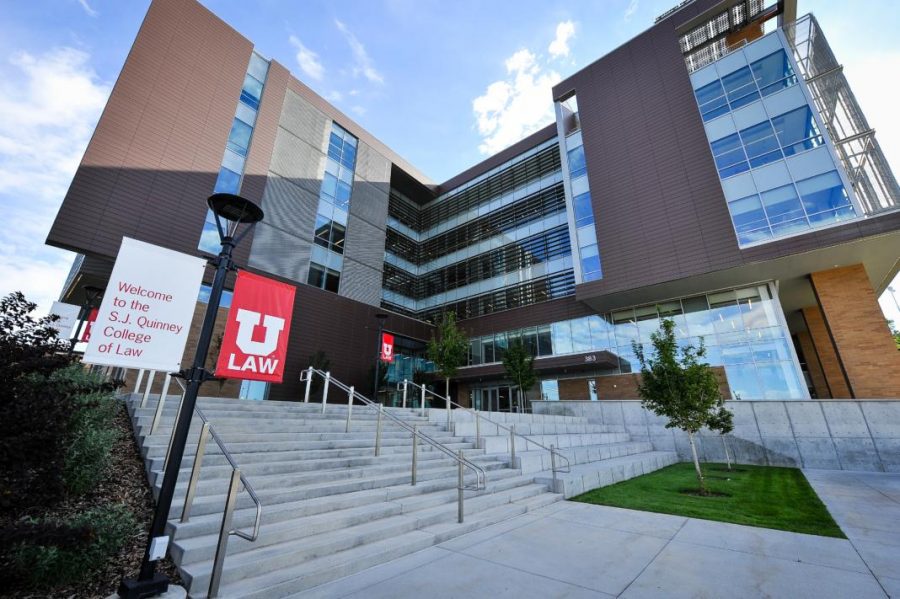Professional Schools See Competitive 2021-22 Admissions Cycle
S.J. Quinney Law School on the University of Utah’s campus. (Chronicle archives)
April 2, 2022
The 2021 admissions cycle was competitive for many professional programs across the country. At the beginning of the pandemic, many students who had recently completed an undergraduate degree found themselves in a position where going into graduate programs might not have been the best option. Perhaps it was the extra financial burden amid an uncertain economic landscape or the unavailability of application prerequisites like getting experience within the profession or volunteer work.
With the 2022 application cycle for medical and law schools coming to a close within the next several months, admissions committees are again finding themselves with an unprecedented number of qualified applicants.
According to the American Bar Association’s collection of 509 disclosures — an admissions disclosure for all accredited law schools — there were over 376,000 applications completed to law schools in 2020.
The 50th percentile of LSAT scores and GPAs from 2020’s matriculated class were 156.8 and 3.49, respectively. LSAT scores can range from 120 to 180.
In 2021, there were over 475,000 applications completed. The 50th percentile of LSAT scores and GPAs from 2021’s enrolled class were 156.49 and 3.51, respectively.
“[My office] noticed, both nationally and locally, that a lot of people who have really strong statistics are jumping back into the application pool,” said Reyes Aguilar, the associate dean for admissions and financial aid at the S. J. Quinney College of Law. “This leads to two big impacts: a larger pool and a stronger pool of applicants as measured by GPA and LSAT scores. This made the 2021 application cycle an unusually competitive year from the perspective of applicants.”
According to Aguilar, the 2021 application cycle at the University of Utah was historic.
“First, it was the result of an applicant pool that had the largest single-year increase that we’ve seen in our history,” Aguilar said. “It was also the first year where we had a student-wide population that was majority women. Then, after combining the LSATs and GPAs, the class was the highest-scoring class we’ve ever had.”
Aguilar said this application increase is substantial.
“People want to enter a good-paying job market right out of college and are weighing their options,” Aguilar said. “It was also an election year, and there’s always an increase in applications when there is a national election. … The U was actually pushing a 35% increase, and I think that’s because there are a lot of good things happening in Utah.”
According to Aguilar, many students noted in their application that during the pandemic, they were able to spend a lot of time in Utah.
“Applicants were also spending a lot of time skiing or hiking here, and the discovery of Utah during that period attracted students to our school,” Aguilar said. “Specifically, the U has two nationally-ranked programs in environmental and intellectual property law, plus Utah’s economy is booming. I think this, coupled with people discovering Utah, made people say to themselves that [the U] is a particularly good place to attend law school.”
Medical schools across the nation show a similar trend in the number and statistics of applicants. According to applicant and matriculant data from the Association of American Medical Colleges, the 2020 application cycle saw a total of more than 53,000 applications.
The mean MCAT and GPA scores for the matriculated 2020 class of over 22,000 were 511.5 and 3.73, respectively. A total MCAT score can range from 472 to 528.
The 2021 application cycle saw a total of more than 62,000 applications. The mean MCAT and GPA scores for the matriculated class were 511.9 and 3.74, respectively.
Petros Minasi, the senior director of pre-health programs for Kaplan educational and training services with over 20 years of experience in consulting pre-med students, said the number of applications for medical schools has increased all over the country, which has been concerning for students.
“One of the biggest things that [has] happened is this kind of ‘call to action’ in the healthcare field,” Minasi said. “Students are definitely gravitating towards the healthcare profession because they have seen a public health emergency come to life in front of their eyes.”
According to Minasi, it has been difficult to get into medical school for a very long time.
“For most students, it’s been a life-long dream,” Minasi said. “We don’t know what the 2022 application cycle will bring, but if the trend continues to follow what we’ve been seeing, interest will remain high for the foreseeable future.”
Minasi recommends applicants make sure their applications are strong by having high GPAs, compelling personal statements and high MCAT scores.
“The silver lining is that there will also be continued opportunities for students to virtually gain experiences in areas that they might not have [had access to] before the pandemic occurred,” Minasi said. “These trends should not discourage anyone from applying, because this process will always be a challenge and those who want to pursue it should continue to pursue it.”








